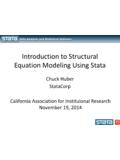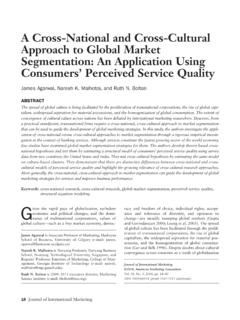Transcription of A General Multilevel SEM Framework for Assessing ...
1 A General Multilevel SEM Framework for Assessing Multilevel MediationKristopher J. PreacherUniversity of KansasMichael J. ZyphurUniversity of MelbourneZhen ZhangArizona State UniversitySeveral methods for testing mediation hypotheses with 2-level nested data have been proposed byresearchers using a Multilevel modeling (MLM) paradigm. However, these MLM approaches do notaccommodate mediation pathways with Level-2 outcomes and may produce conflated estimates ofbetween- and within-level components of indirect effects. Moreover, these methods have each appearedin isolation, so a unified Framework that integrates the existing methods, as well as new multilevelmediation models, is lacking. Here we show that a Multilevel structural equation modeling (MSEM)paradigm can overcome these 2 limitations of mediation analysis with MLM. We present an integrative2-level MSEM mathematical Framework that subsumes new and existing Multilevel mediation ap-proaches as special cases.
2 We use several applied examples and accompanying software code to illustratethe flexibility of this Framework and to show that different substantive conclusions can be drawn usingMSEM versus : Multilevel modeling, structural equation modeling, Multilevel SEM, mediationSupplemental materials: in behavioral, educational, and organizational re-search settings often are interested in testing mediation hypotheseswith hierarchically clustered data. For example, Bacharach, Bam-berger, and Doveh (2008) investigated the mediating role of dis-tress in the relationship between the intensity of involvement inwork-related incidents and problematic drinking behavior amongfirefighting personnel. They used data in which firefighters werenested within ladder companies and all three variables were as-sessed at the subject level. Using data from customer serviceengineers working in teams, Maynard, Mathieu, Marsh, and Ruddy(2007) found that team-level interpersonal processes mediate therelationship between team-level resistance to empowerment andindividual job satisfaction.
3 Both of these examples and manyothers involve data that vary both within and between higherlevel units. Traditional methods for Assessing mediation ( ,Baron & Kenny, 1986; MacKinnon, Lockwood, Hoffman, West, &Sheets, 2002; MacKinnon, Warsi, & Dwyer, 1995) are inappro-priate in these Multilevel settings, primarily because the assump-tion of independence of observations is violated when clustereddata are used, leading to downwardly biased standard errors ifordinary regression is used. For this reason, several methods havebeen proposed for addressing mediation hypotheses when the dataare hierarchically recommended procedures for testing Multilevel mediationhave been developed and framed almost exclusively within thestandard Multilevel modeling (MLM) paradigm (for thoroughtreatments of MLM, see Raudenbush & Bryk, 2002, and Snijders& Bosker, 1999) and implemented with commercially availableMLM software, such as SAS PROC MIXED, HLM, or example, some authors have discussed models in which theindependent variableX, mediatorM, and dependent variableYallare measured at Level 1 of a two-level hierarchy (a 1-1-1 design,adopting notation proposed by Krull & MacKinnon, 2001),1andslopes either are fixed (Pituch, Whittaker, & Stapleton, 2005) orare permitted to vary across Level-2 units (Bauer, Preacher, & Gil,2006; Kenny, Korchmaros, & Bolger, 2003).
4 Other mediationmodels have also been examined, including mediation in 2-2-1designs, in which bothXandMare assessed at the group level(Krull & MacKinnon, 2001; Pituch, Stapleton, & Kang, 2006), andmediation in 2-1-1 designs, in which onlyXis assessed at thegroup level (Krull & MacKinnon, 1999, 2001; MacKinnon, 2008;Pituch & Stapleton, 2008; Raudenbush & Sampson, 1999).Each of these approaches from the MLM literature was sug-gested in response to the need to estimate a particular model to testa mediation hypothesis in a specific design. However, the MLMparadigm is unable to accommodate simultaneous estimation of a1We slightly alter the purpose of Krull and MacKinnon s (2001) nota-tion to refer to data collection designs rather than to models. The modelswe propose for various Multilevel data designs are not consistent withmodels that have appeared in prior J. Preacher, Department of Psychology, University of Kan-sas; Michael J.
5 Zyphur, Department of Management and Marketing, Uni-versity of Melbourne, Melbourne, Victoria, Australia; Zhen Zhang, W. School of Business, Arizona State thank Tihomir Asparouhov, Bengt Muthe n, Vince Staggs, and SonyaSterba for helpful comments. We also gratefully acknowledge Zhen Wangfor permitting us to use his data in Examples 2 and concerning this article should be addressed to Kristopher , Department of Psychology, University of Kansas, 1415 JayhawkBoulevard, Room 426, Lawrence, KS 66045-7556. E-mail: Methods2010, Vol. 15, No. 3, 209 233 2010 American Psychological Association1082-989X/10/$ DOI: of other three-variable Multilevel mediation relationshipsthat can occur in practice (see Table 1; models for some of thesedesigns were also treated by Mathieu & Taylor, 2007). Designs 1and 2 in Table 1 cannot be accommodated easily or completely inthe MLM Framework , because multivariate models require signif-icant additional data management (Bauer et al.)
6 , 2006), and MLMdoes not fully separate between-group and within-group effectswithout introducing bias. Designs 3 through 7 in Table 1 cannot beaccommodated in the MLM Framework at all because of MLM sinability to model effects involving upper level dependent this article, we first explain these two reasons in detail andshow how they are circumvented by adopting a Multilevel struc-tural equation modeling (MSEM) Framework for testing multilevelmediation. Because a General Framework for Multilevel mediationin structural equation modeling (SEM) has yet to be presented, wethen introduce MSEM and show how Muthe n and Asparouhov s(2008) General MSEM mathematical Framework can be applied ininvestigating Multilevel mediation . We show how all previouslyproposed Multilevel mediation models as well as newly proposedmultilevel mediation models can be subsumed within the MSEM Framework . Third, we present several empirical examples (withthoroughly annotated code) in order to introduce and aid in theinterpretation of new and former Multilevel mediation models thatthe MSEM Framework , but not the MLM Framework , can accom-modate.
7 The primary contributions of this article are to show (a)how MSEM can separate some variables and effects into within-and between-group components to yield a more thorough and lessmisleading understanding of indirect effects in hierarchical dataand (b) how MSEM can be used to accommodate mediationmodels containing mediators and outcome variables assessed atLevel 2 ( , bottom-up effects). We advocate the use of MSEMas a comprehensive system for examining mediation effects inmultilevel Limitation of MLM Framework for MultilevelMediation: Conflation of Between and Within Effects(Designs 1 to 3 in Table 1)In two-level designs, it is possible to partition the variance of avariable in clustered data into two orthogonal latent components,theBetween (cluster) componentand theWithin (cluster) compo-nent(Asparouhov & Muthe n, 2006). Variables assessed at Level 2have only Between components of variance. Variables assessed atLevel 1 typically have both Between and Within components,although in some cases a Level-1 variable may have only a Withincomponent if it has no between-group ,3If a variable hasboth Between and Within variance components, the Between com-ponent is necessarily uncorrelated with the Within component ofthat variable and the Within components of all other variables inthe model.
8 Similarly, the Within component of a variable is nec-essarily uncorrelated with the Between component of that variableand the Between components of all other variables in the refer to effects of Between components (or variables) on otherBetween components (or variables) asBetween effectsand toeffects of Within components (or variables) on other Within com-ponents (or variables) asWithin effects. Because Between andWithin components are uncorrelated, it is not possible for a Be-tween component to affect a Within component or vice applications of Multilevel modeling do not distinguishBetween effects from Within effects and instead report a singlemean slope estimate that combines the two (see, relatedly, Chan,1998; Cheung & Au, 2005; Klein, Conn, Smith, & Sorra, 2001).This is an important issue for mediation researchers to consider;the use of slopes that combine Between and Within effects caneasily lead to indirect effects that are biased relative to their truevalues, because the component paths may conflate effects that arerelevant to mediation with effects that are the Within effect of a Level-1 predictor is different from theBetween effect ( , a compositional or contextual effect exists;Raudenbush & Bryk, 2002), the estimation of a single conflatedslope ensures that regardless of the level for which the researcherwishes to make inferences the resulting slope will mischaracter-ize the data.
9 The problem of conflated Within and Between effectsin MLM is already well recognized for ordinary slopes in multi-level models ( , Asparouhov & Muthe n, 2006; Hedeker &Gibbons, 2006; Kreft, de Leeuw, & Aiken, 1995; Lu dtke et al.,2008; Mancl, Leroux, & DeRouen, 2000; Neuhaus & Kalbfleisch,1998; Neuhaus & McCulloch, 2006), but has been underempha-sized in literature on Multilevel illustrate why this issue is problematic for mediation re-search, we will consider the case in whichXis assessed at Level2 andMandYare assessed at Level 1 ( , 2-1-1 design). Theeffect ofXonYmust be a strictly Between effect; becauseXisconstant within a given group, variation inXcannot influenceindividual differences within a group (Hofmann, 2002).5 There-fore, any mediation of the effect of a Level-2 Xmust also occur ata between-group level, regardless of the level at whichMandYareassessed, because the only kind of effect thatXcan exert (whetherdirect or indirect) must be at the between-group level.
10 In fact, anymediation effect in a model in which at least one ofX, M,orYisassessed at Level 2 must occur strictly at the between-group consider the 2-1 portion of the 2-1-1 design. The firstcomponent of the indirect effect (a, the effect ofXonM)isestimated properly in standard MLM. That is, the effect ofXonMand the effect ofXonYare unbiased in the MLM Framework .(However, it is not generally recognized that at an interpreta-2 The Between/Within variance components distinction pertains to latentsources of variance. This concept is related to, but distinct from, the groupmean and grand mean centering choices commonly discussed for observedvariables in the traditional MLM literature. In the MSEM approach, ob-served Level-1 variables are typically either grand mean centered or notcentered prior to analysis. In either case, in MSEM all Level-1 variables aresubjected to implicit, model-based group mean centering by default unlessconstraints are applied to the rare cases it is possible for a Level-1 variable to have a negativeestimated Level-2 variance (Kenny, Mannetti, Pierro, Livi, & Kashy,2002), but we do not discuss such cases are Krull and MacKinnon (2001), MacKinnon (2008), andZhang, Zyphur, and Preacher (2009), who explicitly separated the Withinand Between effects in the 1-1 portion of a mediation model for 2-1-1 is assumed here that, ifXis a treatment variable, individuals withina cluster receive the same dosage or amount of treatment.)


